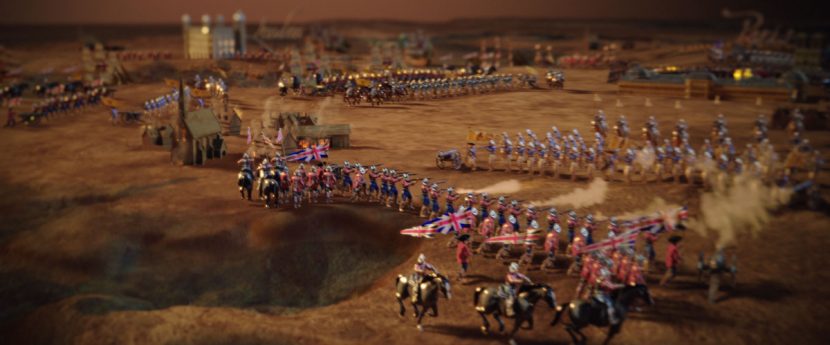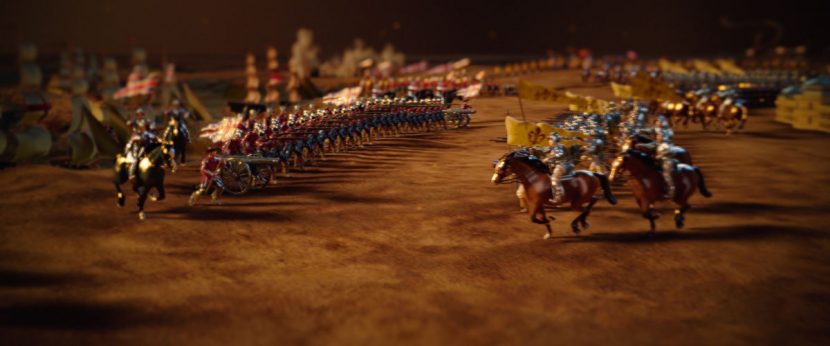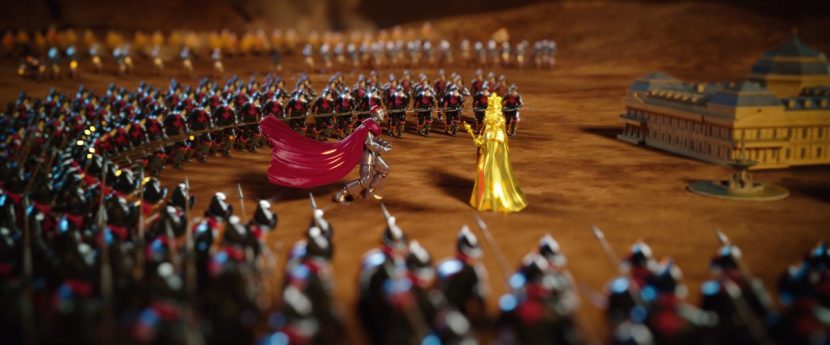The Three Musketeers opens with a main titles sequence that literally maps out the conflicts of Europe at the time of Louis XIII, as the camera flies above miniature soldiers caught mid-battle on a parchment map. Mr. X Inc. creative lead James Cooper takes us through the distinctive 1,642 frame, tilt-shift inspired opening.
Click here to read fxguide’s interview with visual effects supervisor Dennis Berardi about Mr. X’s effects for The Three Musketeers.
fxg: As the creative lead, how did this opening sequence come together in your mind?
Cooper: Paul W. S. Anderson, the director, wanted to open the film in a really dramatic way, but with something that was not actually a filmed sequence. There were a bunch of talking points for background that he wanted to hit and have an interesting visual component to. We talked about a lot of ideas – he had a map of the world at that time, ie. Europe, and we would transfer into a visual representation of the background of what was happening politically at the time.
So we hit upon this idea of starting on a two-dimensional map and then we would fall into it, which would then become a dimensionalized world. We would see some of the events the voice-over was talking about. We wanted the world to come out of the page of the map, so we kept the parchment idea – and then as we fall in the ground itself becomes parchment but also gets that topographic dimensionality that would allow for interesting and dynamic camera moves.

We decided that the coolest thing to do as visuals for the voice-over would be to create little hand made lead painted toy soldiers in various battle formations. The idea was that effectively France was surrounded on all fronts by enemies and the King and Queen were more all less besieged by the Cardinal and his guards.
There’s a transitional point as we fly past the text of the countries and oceans, we start seeing the soldiers – it’s in between the two-dimensional map and the 3D world. Here we bring out the mountains and valleys and the terrain of all the buildings and soldiers.
fxg: How did you design things out?
Cooper: I designed the sequence along those lines, starting with a two-dimensional map of Europe and then created this dynamic move as we go through and started populating it with soldiers. Then we thought we may as well have them firing at each other so we created a bunch of explosions and musket blasts and ships coming into port at shoreline, and more action-oriented sequences – even though it’s all a still life.
fxg: How did the creation of the environments and soldiers evolve?
Cooper: Initially I thought it would be interesting to make an etched scene, as they would have done in that day – literally they would have etched wood or metal and run it through a press to create images. But it became a little too complicated and confusing in stereo to achieve that. Paul certainly liked the idea of the toy soldiers, so we decided to go with that route, which wound up being a very interesting and dynamic sequence that is probably a lot more powerful than this straight graphic etched look.
fxg: Can you talk about the design of the tilt-shift and miniaturized approach to the opening?
Cooper: Once we had settle on the lead painted soldiers, I thought we should really go for the miniaturized look and keep a fairly shallow depth of field and that swing and tilt defocusing aspect.
fxg: Did you always intend for it to be completely CG?
Cooper: We did. Some of the musket blasts were shot elements, some shot for the film to be used as effects elements, and some we had already in our library.
fxg: Was it something you boarded or previs’d?
Cooper: We did do this in a manner of speaking. I started with the design of the map, and once Paul was happy with this, then we started thinking about well, how does it go, how does it work? I thought it should feel two-dimensional at the beginning, even though it’s a stereo show, then as we move into this map and pick up acceleration with the camera, that the dimensionality would come out at us, as we dropped into the world. Literally it was supposed to feel like the camera was dropped from the sky and landed in this other world.
We blocked out the voice-over and wanted to hit very specific key story points, and that facilitated the camera move. We had an original audio cut of the voice which we blocked out as a simple camera move, putting boxes where we think the army should go. That actually turned out to be way too fast, because as you were flying in and around, it didn’t register anything. So we had to parse out the voice over a little bit with Paul’s blessing, to try and stretch out the sequence and give it some breathing space.
Once we had a timing map done of the entire sequence, moving through to the end shot and the main title, then we started populating it with stand-ins for the soldiers. In the meantime we were developing the soldier assets. I sourced out hundreds of different painted toy references.

fxg: So how did that then move into production?
Cooper: As we went along and Paul saw iterations, he would say, ‘Yeah that looks great but we need more!’ So we wound up having to create more and more soldiers and more ships and more explosions and musket fires. At one point Paul had this great idea of the camera running a gauntlet of the soldiers firing at each other – that became quite an amazing part of the sequence.
Because my initial references were of old war scenes – in those etched maps there were always villages on fire and horses rearing – so we wanted to incorporate those things. Another part of the miniaturization was that we added dust particles and flying embers in the air as the camera swirls past, which really gives that sense of miniaturization and the heat of war going on.
fxg: What approach did you take to modeling and lighting the soldiers?
Cooper: They had to always look hand-painted. We talked early about have them be chipped a little, but came to the decision in the end that in theory this was the King or Cardinal’s map, so they would be pristine, which we kept them as. In terms of the modeling, we sourced out many different references for the soldiers and did tons of research of what the actual uniforms of the countries would look like.
Fortunately, we were at the same time creating soldier models for actual live action shots in the film, so there was a lot of photoreal work we could take from them. We could re-purpose those as toy soldiers by giving them a slightly rougher look – they’re a little bit more modeled and don’t look so real, and we also give them a hand-painted look. We used Maya for modeling, and had 3ds Max and FumeFX for smoke and effects elements.
fxg: How were the environments created?
Cooper: I sought out a whole bunch of different parchment textures and we hit upon a couple that we felt were really good. There were three or four layers – the base of the parchment texture to a different parchment bump map that created textural elements. It was basically placed on a large highly defined grid that was deformed using actual topographical information of Europe from that area, to create the Pyrenees and the Alps and other geographical formations. It had to stay fairly simple in the parchment, otherwise there would have been some crazy render times. Another layer was a very raw piece of paper that had fibers in it that added a little touch of realism.
fxg: How did you dial in the tilt-shift look?
Cooper: We wound up doing both the depth of field and motion blur in Nuke. We had so many different layers and each CG pass had a long rendering time. One of the issues we were experiencing with motion blur and depth of field as the camera was flying through – we got to the point where nothing felt like it was in focus, ever. That’s because our motion blur was probably a little too strong. So we really wanted to control that in compositing to get that perfect point where there wasn’t enough motion blur that the images felt strobing and too much motion blur that they were not in focus.
In terms of the depth of field, Paul loved the swing and tilt look, but wanted to make sure that the talking points were in focus when they needed to be. So we plotted out where that focal plane of the depth of field was going to be hitting the scene as we flew through it.

fxg: How did stereo impact on you for the sequence?
Cooper: We were able to utilize the point clouds and 3D aspects of Nuke for this. I was able to take in the stereo camera from our camera department and then had them put cones where the ends of muzzles were for every soldier, and where the buildings were for the villagers, so that I could place our 2D muzzle flashes in the right 3D space. As we applied that through the Nuke camera, we kept the perspective and the stereoscopy nicely aligned.
fxg: Was there anything else you’d like to add about the sequence?
Cooper: There are some little details that probably won’t get noticed – for example there is in fact a sea monster out in the English Channel. And Paul said at one point while he was reviewing it, ‘You’ve reduced every man in the room to 16 year old boy status,’ so we were really pleased.
All images copyright © 2011 Summit Entertainment and Constantin Film. Courtesy of Mr. X Inc.
